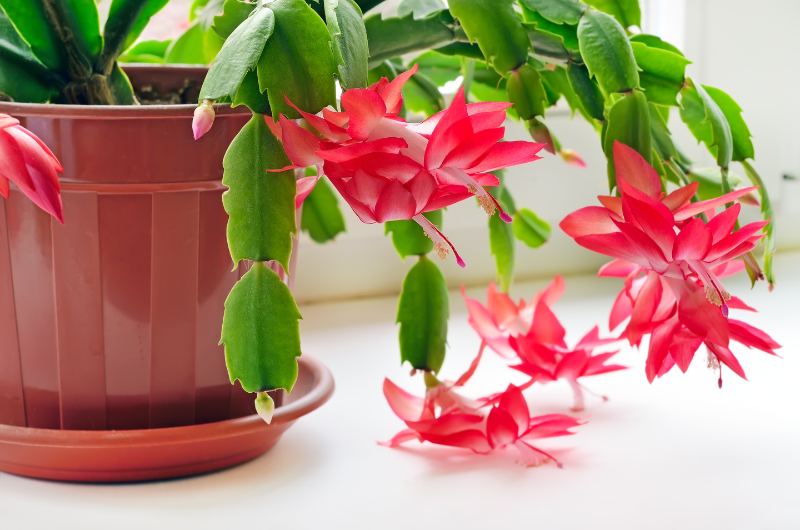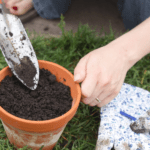The Christmas cactus, with its festive holiday blooms and low-maintenance nature, is a popular gift plant and houseplant for many homes during the winter season.
But how can you keep your Christmas cactus thriving all year long?
Proper Christmas cactus care involves providing the right amount of light, water, humidity, and fertilizer at the correct times.
While they are tropical plants, Christmas cacti are actually epiphytes that grow in tree branches rather than on the desert floor. This means they have slightly different care needs than true desert cacti.
With just a few tips and tricks for Christmas cactus care, you’ll have a healthy, long-lasting plant that flowers beautifully every holiday season.
In this article, you’ll learn insider secrets for encouraging vibrant blooms, proper repotting techniques, and how to keep your Christmas cactus flourishing.
Let’s get started!
Choosing the Right Pot and Soil for Your Christmas Cactus

The key to successful Christmas cactus care starts with choosing the right pot and soil for your plant.
Proper potting and soil selection are essential for providing the optimal growing conditions that will keep your Christmas cactus healthy and thriving.
When it comes to selecting a pot, opt for one with a drainage hole to prevent water from pooling around the roots and causing rot.
A pot that is slightly larger than the current one will allow for future growth, but avoid choosing one that is too big, as excess soil can lead to overwatering and soggy roots.
The type of soil you use is equally important. Christmas cacti prefer a well-draining soil mix that retains moisture but also allows excess water to pass through easily.
Opt for a soil blend specifically formulated for cacti and succulents, or create your own by combining equal parts potting soil, perlite, and sand. This blend will provide the right balance of moisture retention and drainage for your Christmas cactus.
By selecting the right pot and soil, you’re setting a solid foundation for your Christmas cactus to thrive. With the proper care, your Christmas cactus will be ready to dazzle you with its vibrant blooms during the holiday season.
Essential Watering and Light Requirements for Your Christmas Cactus
Proper watering and providing adequate light are crucial factors in ensuring the health and vitality of your Christmas cactus. The Christmas cactus is native to the tropical rainforests of Brazil, so it thrives in environments that mimic those conditions.
Watering
When it comes to watering, it’s important to strike a balance. Overwatering can lead to root rot, while underwatering can cause the plant to dry out.
The best approach is to wait until the top inch of soil feels dry before watering your Christmas cactus.
Use room temperature water and ensure that the excess water drains out through the pot’s drainage hole. Avoid leaving your plant sitting in standing water, as this can also lead to root rot.
Light
As for light requirements, Christmas cacti prefer bright, indirect light. They can tolerate some direct sunlight, but too much can scorch the leaves.
Place your plant near a window where it can receive bright, filtered light for a few hours a day.
Avoid placing it in direct sunlight, especially during the hottest parts of the day.
If you notice your Christmas cactus becoming pale or leggy, it may be an indication that it needs more light.
Maintaining the Ideal Temperature and Humidity for Your Christmas Cactus
Creating the right environment with the ideal temperature and humidity is essential for the overall well-being of your Christmas cactus. These factors play a crucial role in promoting healthy growth and ensuring the plant’s blooming success.
Temperature
The Christmas cactus thrives in temperatures between 60-70 degrees Fahrenheit (15-21 degrees Celsius).
It is important to protect the plant from extreme temperatures, as both cold drafts and hot air can damage its delicate leaves and stems.
Avoid placing your cactus near heating or cooling vents, as sudden temperature fluctuations can stress the plant.
Humidity
When it comes to humidity, the Christmas cactus prefers a moderate level of moisture in the air. It makes a good bathroom plant.
Aim for humidity levels between 50-60% to provide the optimal growing environment.
To increase humidity, you can use a humidifier, place a tray of water near the plant, or mist the leaves with water periodically.
These measures will help prevent the cactus from drying out and maintain its vibrant, healthy appearance.
How to Create the Ideal Conditions Indoors
Indoor environments often have lower humidity levels, especially during the winter months when the heating is turned on.
To create the perfect conditions for your Christmas cactus, consider placing the pot on a tray filled with pebbles and water.
As the water evaporates, it will increase the moisture around the plant. Remember to refill the tray regularly to maintain the desired humidity.
During the blooming period, it is essential to keep the temperature and humidity consistent.
Avoid placing your Christmas cactus near drafty windows or doors, as this can cause temperature fluctuations that may result in bud drop or stunted growth.
Instead, find a cool spot in your home with indirect light, such as a north or east-facing window, where the temperature and humidity remain relatively stable.
Combatting Pests
When caring for your Christmas cactus, it’s essential to watch out for common pests such as mealybugs, spider mites, and fungus gnats.
These intruders can cause damage to the plant and hinder its growth. If you notice any signs of infestation, act promptly to eliminate the pests and protect your cactus.
Applying a solution of water and mild soap can help control mealybugs and spider mites, while sticky traps can be useful in catching fungus gnats.
Regularly inspecting your plant and maintaining good hygiene can also prevent pest problems from escalating.
Pruning

Pruning your Christmas cactus after it blooms is crucial for encouraging branching and maintaining a compact and attractive shape.
To prune, simply remove any dead or dying segments with clean, sharp shears.
This will stimulate new growth and ensure the plant remains healthy and vibrant.
Repotting
Repotting should be done every three to four years or when the cactus becomes rootbound.
Choose a slightly larger container with good drainage to accommodate the growing roots.
When repotting, be careful not to damage the delicate roots and use well-draining soil to prevent waterlogging.
Propagation and Long-Term Care for Your Christmas Cactus
Once you’ve mastered the basics of Christmas cactus care, you can explore propagation methods and learn how to provide long-term care to ensure the continued health and beauty of your plant.
Propagation
To propagate your Christmas cactus, you can take stem cuttings and root them in perlite or coarse sand.
Select a healthy segment of the plant and make a clean cut just below a leaf node.
Allow the cutting to sit in a shaded area for a few days to allow the cut to callus over.
Once the cut has callused, place the cutting in a well-draining medium and mist it regularly to maintain moisture levels.
Within a few weeks, roots will develop, and you’ll have a new Christmas cactus to care for.
Long-term Care
Long-term care for your Christmas cactus involves providing it with the right conditions and regular maintenance.
During the growing season, which typically spans spring and summer, feed your Christmas cactus with a diluted fertilizer every two weeks.
Once flower buds start to form, stop feeding to avoid damage to the buds.
After the holiday season, when the blooming period is over, move your plant to a cool and humid spot with temperatures ranging between 60-70 degrees Fahrenheit. This will allow the plant to rest and prepare for the next blooming cycle.
Regular pruning is essential for maintaining the shape and health of your Christmas cactus.
After it blooms, prune the plant by pinching or cutting back the segments to promote branching.
This will result in a fuller and bushier plant. Additionally, keep an eye out for signs of overwatering or dry soil, as these can negatively impact the health of your cactus.
If your plant becomes rootbound, it’s time to repot it into a slightly larger container with good drainage.
You May Also Like:
Your Guide To Exceptional Jade Plant Care – Grow Them Right!
FAQs
What is the Christmas cactus and where is it native to?
The Christmas cactus is botanically known as Schlumbergera x buckleyi. Unlike desert cacti, it originates from tropical rainforests, not arid regions. In its native environment, this epiphytic plant grows on branches of trees and thrives in humid, warm conditions with filtered sunlight. During the winter months, the Christmas cactus produces its signature tubular blooms in shades of pink, red, white, orange, and purple, which is how it got its festive common name. Its tropical origins mean this plant has different care needs than desert cactus species.
What are the 3 types of Christmas cactus?
There are different types of holiday cacti, which include the Thanksgiving cactus, Christmas cactus, and Easter cactus, which bloom at different times of the year. Knowing the specific care requirements for each type will help you maintain healthy and vibrant plants throughout the seasons.
What is the best way to water and feed my Christmas cactus?
When it comes to watering your Christmas cactus, it’s important to wait until the top third of the soil is dry before watering thoroughly. For example, let the top 2 inches dry out if the plant is in a 6 inch pot. This usually means watering every 2-3 weeks. Always allow excess water to drain fully from the pot’s holes and empty any water that collects in the tray so the plant doesn’t sit in water. Fertilize your Christmas cactus with a balanced houseplant fertilizer, applying it every 2 weeks during the active growing period of spring through early fall. In the fall and winter, monthly feedings are sufficient to support flowering. Pruning back branches by one-third in late spring will promote bushier growth and more blooms.







